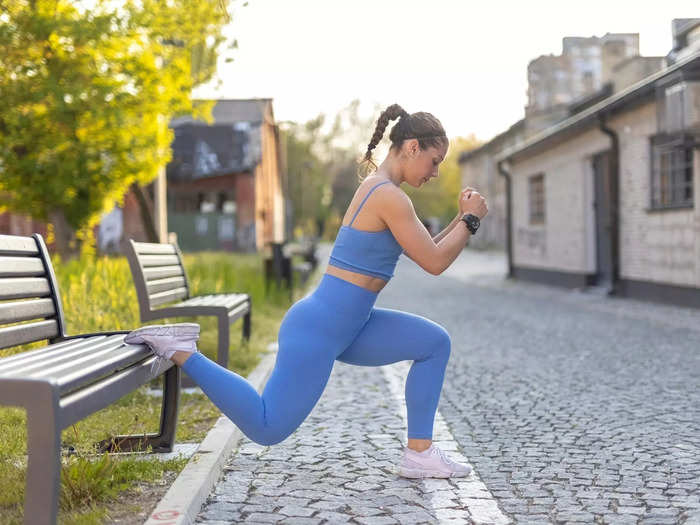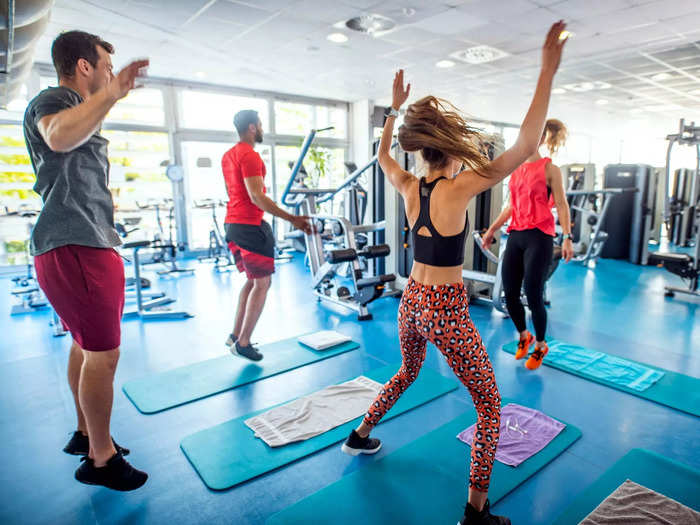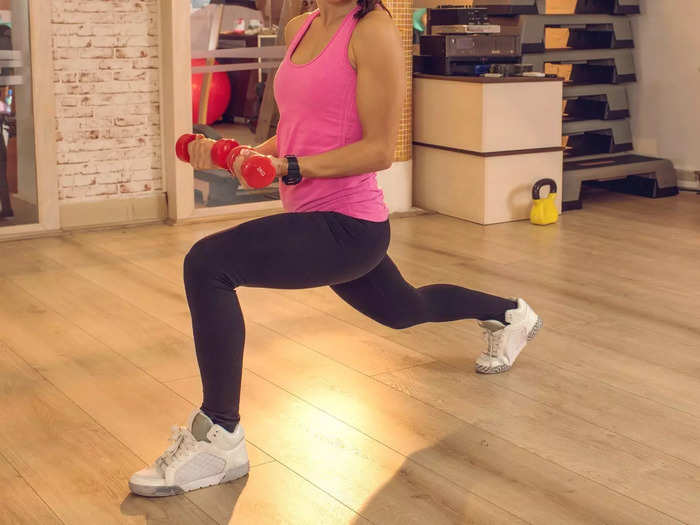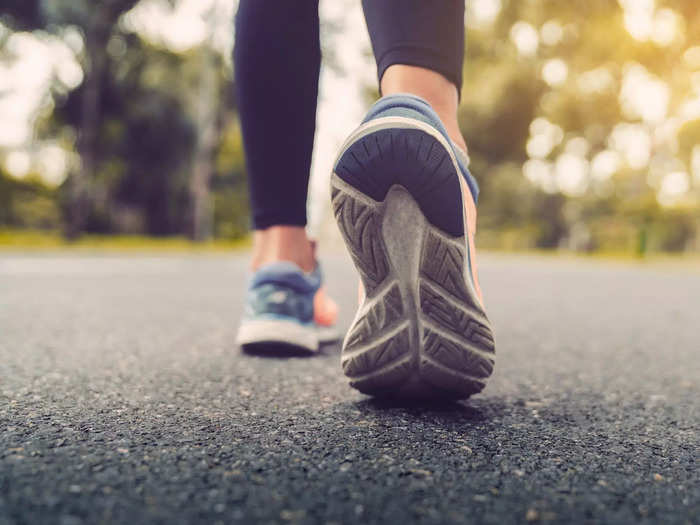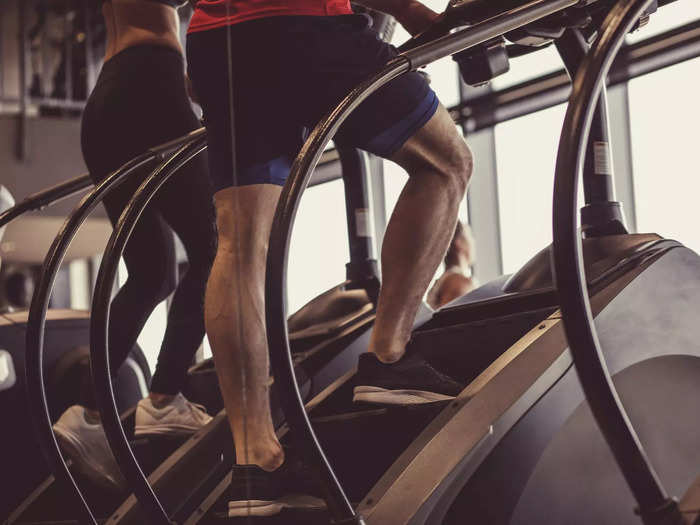The latest fad workout may leave you exhausted, but it's not likely to be the best strategy for gains, according to trainers.Getty
- Viral workout trends often promise impressive results, but can waste your time or cause injury.
- In 2022, personal trainers debunked fitness challenges, the HIIT obsession, and other fads.
Get abs fast. Be your best self. Burn fat and build a bigger booty. These are some of the enticing promises of popular viral workouts — but if you want to make gains that will last, you're better off sticking to a simple, sustainable workout, according to personal trainers.
In 2022 fitness fads caught on at a fast and furious pace on apps like TikTok, but many of them recycle old ideas that have long been debunked by professional coaches, trainers, and exercise scientists. The most popular rely on extreme recommendations (often with eye-popping "before and after" pictures), but may leave you sore, burned out, and even injured, not stronger. Instead of wasting your time with long hours of cardio, endless HIIT, or strict rules, some of the best gains can be made by making small, smart changes to your routine over time, trainers told Insider.
Here are some of the fads to steer clear of if you want to make lasting changes to your health and fitness in 2023, and what to do instead.
75 Hard likely won't give you lasting good habits.
Outdoor exercise is a great habit, but trying to complete two workouts a day, every day, for the "75 Hard" challenge is tough to sustain. Getty
The "75 Hard" challenge is a grueling test of physical discipline and mental toughness that went viral on TikTok and Instagram in 2022.
It involves sticking to five rules for 75 days straight — skip any of them at any point, for any reason, and you'll need to start over from day one.
The daily requirements are:
- take a progress selfie
- drink a gallon of water
- read 10 pages of a book
- follow a diet — no alcohol or cheat meals
- finish two 45-minute workouts, one of which must be outside
While social media highlights plenty of "before and after" results, personal trainer Noam Tamir said some elements of the challenge are overkill.
"I think it could be great for some people, but for the majority of us, it's not so great," he previously told Insider. "They've created this idea based on extremes."
Tamir said 90 minutes of exercise a day may be excessive for fitness beginners, potentially causing injury or overtraining.
Even if you finish the challenge, it's unlikely the habits will stick. As a result, you'd be better off gradually building up to workouts you can do consistently, since slow and steady leads to the best long-term results, Tamir said.
Too many HIIT classes could do more harm than good.
More than two or three HIIT classes a week could make it hard for your body to recover enough to get the benefits of intense exercise. Getty/Azman Jaka
High intensity interval training, or HIIT for short, is a popular workout format that involves raising your heart rate with short periods of max-effort exercises with minimal rest.
The right kind of HIIT has health benefits like building endurance and stamina, producing mood-boosting endorphins, and torching calories (if weight loss is your goal).
However, many people make the mistake of overdoing HIIT workouts, according to personal trainer Amanda Butler, who has worked for a well-known gym franchise famous for HIIT classes and shares her advice on TikTok.
Butler told Insider she saw clients showing up for strenuous workouts five, six, or even seven days a week — and as a result, they made little to no progress after years of hard work.
"They aren't able to build muscle or lose weight because there's no progressive overload and they're burning their bodies out," she said.
To improve your fitness, it's important to balance training with recovery, so your body can repair and build back stronger, according to fitness coaches.
Research suggests too much HIIT can hurt your metabolism. It's also possible to overdo any type of exercise, so look out for red flags of overtraining like constant soreness and fatigue.
Combo exercises may not be effective for your goals.
The right weight for a bicep curl is way too light for a lunge, so mixing them doesn't make sense, according to a personal trainer. BraunS/Getty images
One popular standby in HIIT and other group fitness classes is the combination exercise, which links two or more movements together back-to-back using the same weight.
While time-saving and good for raising your heart rate, these two-for-one moves are a waste of time if you're trying to build muscle and strength, according to personal trainer Miriam Fried.
"You're not getting much out of it or you're hurting yourself," she previously told Insider.
Combination exercises often use relatively small dumbbell weights, and incorporate an upper and lower body movement, like a curl with a lunge, or a squat with a front raise.
The problem is that the muscles of your legs are much larger than your arms, and require a lot more resistance to work hard enough to see results, according to Fried. But a weight heavy enough for your legs is likely too much for your arms, likely leading to bad form and possible injury, she said.
However, not all combination exercises are pointless. Some classic combos are designed to go well together, like a thruster (weighted squat driving up into an overhead press).
It's important to be intentional about your goals, and chose the right weight and movements for what you hope to achieve in each workout, Fried said.
Walking 10,000 steps a day is more than you need to see health benefits.
Walking is fantastic exercise with benefits for your body and mind that start at taking just 2,000 steps a day. TravelCouples/Getty Images
There's no question that walking is a great, accessible form of exercise, and research shows it's linked to benefits like better mood, improved heart health, and lower risk of disease.
But the popular goal of hitting 10,000 steps a day is arbitrary and not based in science — you can start to improve your health in far fewer, studies suggest.
The 10,000 steps trend was originally designed as part of an advertising campaign, without any particular evidence behind the number, according to Daniel Lieberman, a Harvard paleoanthropologist who has studied the evolution of exercise.
Manpo-kei (translated as 10,000-step meter) was invented in the 1960s by the Japanese company Yamasa Tokei — the producer of the first commercial pedometer — which chose the name because it sounded good, Lieberman wrote in his book "Exercised."
Research actually suggests the benefits of walking occur on a spectrum, with as few as 4,400 steps a day linked to a longer life.
And speed matters, too, since studies suggest a brisk pace is linked to more health benefits than the distance alone.
That said, 10,000 steps a day doesn't hurt, but there's no reason to be discouraged if it's not a goal you can hit right away, or consistently. Any amount of walking helps, and it can be a helpful strategy to slowly work up to a habit of walking a little bit more each day, according to the Mayo Clinic.
The stair-stepper workout overpromises muscle-building and fat-burning results.
The stair-stepper isn't any more magical that other cardio machines at the gym. fotostorm/Getty Images
A popular TikTok trend in 2022 suggested the stair-stepper machine could do everything from burn fat and sculpt your abs to build a bigger butt.
The trend also included various "StairMaster hacks" (referring to the brand name which helped popularize the product) like using it hands-free, jumping on it, or enduring long sessions at a time.
While the cardio contraption gets your heart pumping and legs working with an endless series of stairs, personal trainers previously told Insider that there's no special benefit compared to other exercise like running or even walking.
To build muscle, you'd actually be better off lifting weights, according to strength and conditioning coach Mike Boyle.
Trying to hop, balance, or otherwise gyrate on the stair-stepper is an accident waiting to happen, as is spending an excessive amount of time on the machine, he said.
If your goal is more defined ab muscles, what matters is having a relatively low body fat percentage, and good nutrition is more important than any special workout, according to personal trainer Noam Tamir.

